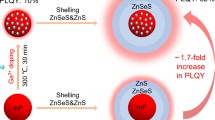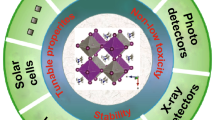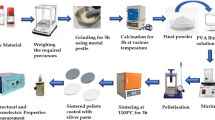Abstract
A series of single-component ScF3:Dy3+, Eu3+, Ce3+ phosphors prepared by means of microwave hydrothermal method were explored for light-emitting diodes. The as-prepared samples were characterized via X-ray diffraction (XRD), scanning electron microscope (SEM), and photoluminescence (PL) spectroscopy. In order to rationalize the experimental results, first-principle calculations based on density functional theory had been carried out to discover electronic structures. PL performance of the RE3+-doped phosphors exhibited well-defined bands in the visible region. By adjusting the ratios of Ce/Dy/Eu, the color of the as-prepared phosphors can vary from blue (0.24, 0.23) to red (0.51, 0.30) across the white (0.34, 0.26) region according to the chromaticity coordinates. The results suggested that the Dy/Eu/Ce-doped ScF3 might act as down-convert phosphors for near ultraviolet light-emitting diodes, especially for white LEDs. What is more, it can also promote a deep comperhension of the relationship between structure and properties in ScF3-based phosphors.

ScF3:RE3+ phosphors with alterable bandgaps can emit light from blue to orange–red across white under the excitation of near ultraviolet light. Introduction of rare earth ions induced the variation of energy band structures in ScF3-based phosphors because of the existence of f, p, and d orbits in RE3+, therein f and p orbits of RE3+ made the band structure downwards, the p hybridizing with Sc-3d promoted the band toward high-energy region.
Highlights
-
Single-phased cubic ScF3:Dy3+, Eu3+, Ce3+ phosphors were synthesized by a simple method.
-
The electronic structures of RE3+-doped ScF3 phosphors were analyzed by the DFT calculations systematically.
-
Emission intensity of as-synthesized phosphors was apparently enhanced via energy transfer processes.
-
Warm white light emission and tunable luminescence in RE3+-doped ScF3 phosphors were realized.










Similar content being viewed by others
References
Nair GB, Swart HC, Dhoble SJ (2019) A review on the advancements in phosphor-converted light emitting diodes (PC-LEDs): phosphor synthesis, device fabrication and characterization. Prog Mater Sci 109:100622
Ren L, Lei X, Du X, Jin L, Chen W, Feng Y (2013) Effect of Eu2O3 concentration on luminescent properties of Ce/Tb/Eu Co-doped calcium borosilicate glass for white LED. J Lumin 142:150–154
Zhou Y, Chen D, Tian W, Ji Z (2015) Impact of Eu3+ dopants on optical spectroscopy of Ce3+: Y3Al5O12-embedded transparent glass-ceramics. J Am Ceram Soc 98:2445–2450
Bachmann V, Ronda C, Meijerink A (2009) Temperature quenching of yellow Ce3+ luminescence in YAG:Ce. Chem Mater 21:2077–2084
Lin CC, Meijerink A, Liu R (2016) Critical red components for next-generation white LEDs. J Phys Chem Lett 7:495–503
Wen D, Kuwahara H, Kato H, Kobayashi M, Sato Y, Masaki T, Kakihana M (2016) Anomalous orange light-emitting (Sr,Ba)2SiO4:Eu2+ phosphors for warm white LEDs. ACS Appl Mater Inter 8:11615–11620
Zhu H, Lin CC, Luo W, Shu S, Liu Z, Liu Y, Kong J, Ma E, Cao Y, Liu R, Chen X (2014) Highly efficient non-rare-earth red emitting phosphor for warm white light-emitting diodes. Nat Commun 5:4312
Li J, Yan J, Wen D, Khan WU, Shi J, Wu M, Su Q, Tanner PA (2016) Advanced red phosphors for white light-emitting diodes. J Mater Chem C 4:8611–8623
Zhou J, Xia Z (2015) Luminescence color tuning of Ce3+, Tb3+ and Eu3+ co-doped and tri-doped Bay2Si3O10 phosphors via energy transfer. J Mater Chem C 3:7552–7560
Shang M, Li C, Lin J (2014) How to produce white light in a single-phase host? Chem Soc Rev 43:1372–1386
Blasse G, Grabmaier BC (1950) Luminescent materials. Manuf Chem Aerosol News 21:335
Liu Y, Liu G, Wang J, Dong X, Yu W (2014) Single-component and warm-white-emitting phosphor NaGd(WO4)2:Tm3+, Dy3+, Eu3+: synthesis, luminescence, energy transfer, and tunable color. Inorg Chem 53:11457–11466
Zhang Y, Geng D, Shang M, Zhang X, Li X, Cheng Z, Lian H, Lin J (2013) Soft-chemical synthesis and tunable luminescence of Tb3+, Tm3+/Dy3+-doped SrY2O4 phosphors for field emission displays. Dalton Trans 42:4799–4808
Shamshad L, Rooh G, Kirdsiri K, Srisittipokakun N, Kim HJ, Kaewkhao J (2016) Development of Li2O-SrO-GdF3-B2O3 oxyfluoride glass for white light LED application. J Mol Struct 1125:601–608
Zhang P, Pu Y, Zhu X, Zheng H, Zhao J, Wu Y, Luo Y, Liu Y (2015) Luminescence properties of Dy3+ doped and Dy3+/Ce3+ co-doped CaO-Al2O3-SiO2-B2O3 glass for led applications. Ceram Int 41:S729–S733
Zhu G, Xie M, Yang Q, Liu Y (2016) Hydrothermal synthesis and spectral properties of Ce3+ and Eu2+ ions doped KMgF3 phosphor. Opt Laser Technol 81:162–167
Masai H, Yanagida T (2015) Emission property of Ce3+-doped Li2O-B2O3-SiO2 glasses. Opt Mater Express 5:1851–1858
Zeng H, Yang Y, Lin Z, Liang X, Yuan S, Chen G, Sun L (2011) The effect of B2O3 on the luminescent properties of Eu ion-doped aluminoborosilicate glasses. J Non-Cryst Solids 357:2328–2331
Lin Z, Zeng H, Yang Y, Liang X, Chen G, Sun L (2010) The effect of fluorine anions on the luminescent properties of Eu-doped oxyfluoride aluminosilicate glasses. J Am Ceram Soc 93:3095–3098
Zhu J, Xia Z, Zhang Y, Molokeev MS, Liu Q (2015) Structural phase transitions and photoluminescence properties of Eu3+ doped Ca2-xBaxLaNbO6 phosphors. Dalton Trans 44:18536–18543
Rahman P, Green M (2009) The synthesis of rare earth fluoride based nanoparticles. Nanoscale 1:214–224
Wang Z, Chan HLW, Li H, Hao JH (2008) Highly efficient low-voltage cathodoluminescence of LaF3:Ln3+ (Ln=Eu3+, Ce3+, Tb3+) spherical particles. Appl Phys Lett 93:141106
Zhu R, Zeng Y, Liang S, Zhang Y, Qi Y, Liu Y, Lyu Y (2019) Regulated morphology of ScF3: Eu3+, Bi3+ microcrystals: microwave assisted hydrothermal synthesis, structure and luminescence properties. J Solid State Chem 269:447–453
Han L, Wang Y, Guo L, Zhao L, Tao Y (2014) Multifunctional ScF3:Ln3+ (Ln = Tb, Eu, Yb, Er, Tm and Ho) nano/microcrystals: hydrothermal/solvothermal synthesis, electronic structure, magnetism and tunable luminescence properties. Nanoscale 6:5907–5917
Segall MD, Lindan P, Probert MJ, Pickard CJ, Hasnip PJ, Clark SJ, Payne MC (2002) First-principles simulation: ideas, illustrations and the CASTEP code. J Phys Condens Matter 14:2717–2744
Perdew JP, Chevary JA, Vosko SH, Jackson KA, Pederson MR, Singh DJ, Fiolhais C (1992) Atoms, molecules, solids, and surfaces—applications of the generalized gradient approximation for exchange and correlation. Phys Rev B 46:6671–6687
Min X, Fang M, Huang Z, Liu Y, Tang C, Wu X (2015) Luminescence properties and energy-transfer behavior of a novel and color-tunable LaMgAl11O19:Tm3+, Dy3+ phosphor for white light-emitting diodes. J Am Ceram Soc 98:788–794
Shi Y, Wang Y, Yang Z (2011) Synthesis and characterization of YNbTiO6:Dy3+ phosphor. J Alloy Compd 509:3128–3131
Blasse G, Brill A (1970) The absorption and emission spectra of some important activators. Philips Tech Rev 31:304–314
Dexter DL (1953) A theory of sensitized luminescence in solids. J Chem Phys 21:836–850
Som S, Mitra P, Kumar V, Kumar V, Terblans JJ, Swart HC, Sharma SK (2014) The energy transfer phenomena and colour tunability in Y2O2S:Eu3+/Dy3+ micro-fibers for white emission in solid state lighting applications. Dalton Trans 43:9860–9871
Mori M, Okada G, Kawaguchi N, Yanagida T (2017) Optical, scintillation and thermally stimulated luminescence properties of Ce-doped yttrium-aluminum-indium garnet. Jpn J Appl Phys 56:012603
Zhang W, Shen H, Hu X, Wang Y, Li J, Zhu Z, You Z, Tu C (2019) Solid-state synthesis, structure and spectroscopic analysis of Dy:CaYAl3O7 phosphors. J Alloy Compd 781:255–260
Ren Q, Wang B, Wu X, Wei T, Huo Z (2016) Luminescence properties and energy transfer in Dy3+ and Eu3+ Co-Doped Sr3Y(PO4)3 phosphor. J Alloy Compd 684:677–682
Colfen H, Mann S (2003) Higher-order organization by mesoscale self-assembly and transformation of hybrid nanostructures. Angew Chem 42:2350–2365
Shruthi DL, Reddy AJ, Kumar GNA, Jayasankar CK, Krishna RH (2019) Judd-Ofelt analysis, electronic and elastic properties from ab-initio study and photo-cathodoluminescence studies of Eu3+ activated CdWO4 nanophosphors. Mater Res Express 6:125053
Li D, Wang J, Dong X, Yu W, Liu G (2013) Fabrication and luminescence properties of YF3:Eu3+ hollow nanofibers via coaxial electrospinning combined with fluorination technique. J Mater Sci 48:5930–5937
Mccamy CS (1992) Correlated color temperature as an explicit function of chromaticity coordinates. Color Res Appl 17:142–144
Acknowledgements
This work was supported by Priority Academic Program Development (PAPD) of Jiangsu Higher Education Institutions.
Author information
Authors and Affiliations
Corresponding authors
Ethics declarations
Conflict of interest
The authors declare that they have no conflict of interest.
Additional information
Publisher’s note Springer Nature remains neutral with regard to jurisdictional claims in published maps and institutional affiliations.
Supplementary information
Rights and permissions
About this article
Cite this article
Zhu, R., Bi, Z., Jia, K. et al. Elucidating the electronic structures and photoluminescence properties of single-phase ScF3:Dy3+, Eu3+, Ce3+ phosphors for LEDs. J Sol-Gel Sci Technol 96, 753–762 (2020). https://doi.org/10.1007/s10971-020-05411-y
Received:
Accepted:
Published:
Issue Date:
DOI: https://doi.org/10.1007/s10971-020-05411-y




